Aiserman M., Gusev L., Rozonoer L., Smirnova l., Tal A. Logic, Automata, and Algorithms
Подождите немного. Документ загружается.

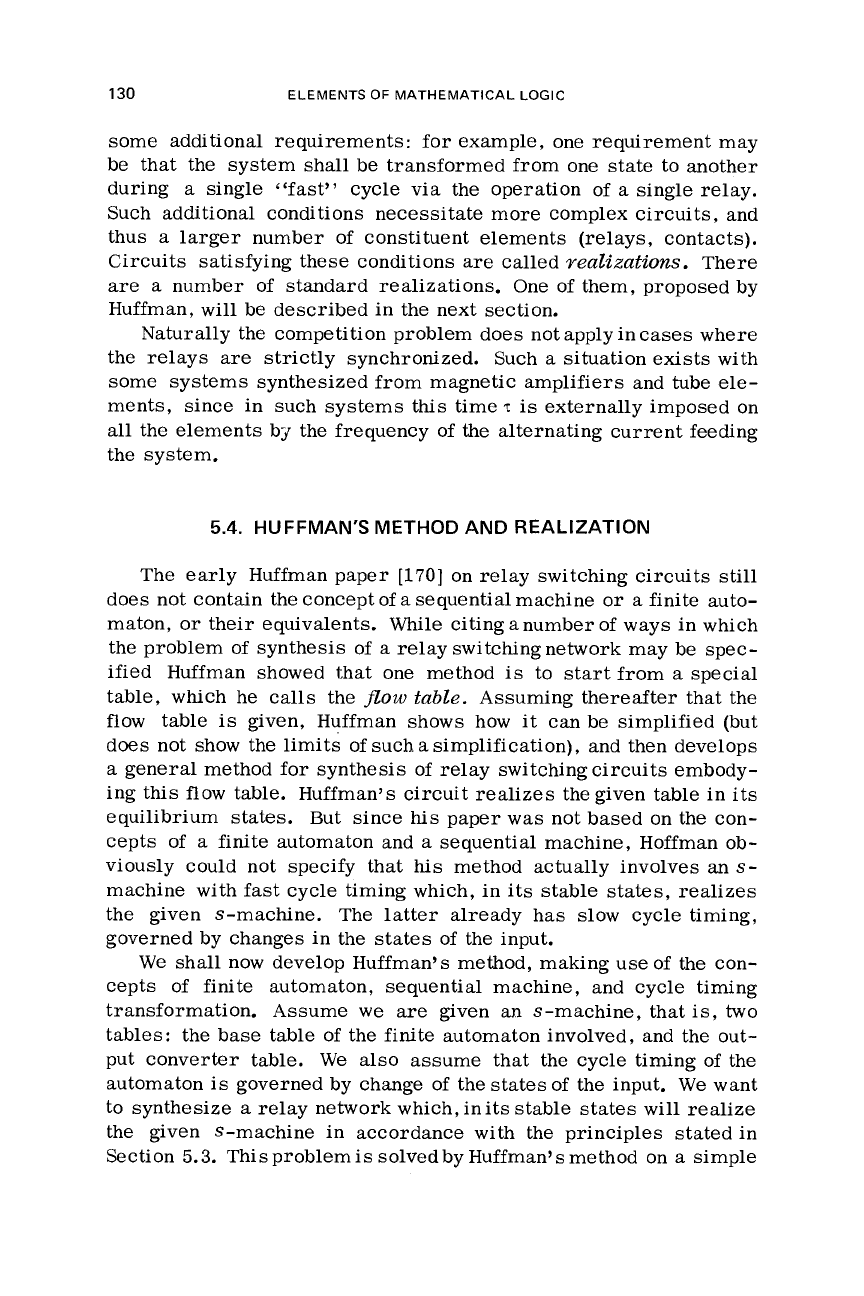
130
ELEMENTS
OF
MATHEMATICAL
LOGIC
some additional requirements: for example, one requirement may
be that the system
shall
be transformed from one state to another
during a single “fast” cycle via the operation of
a
single relay.
Such additional conditions necessitate more complex circuits, and
thus
a
larger number of constituent elements (relays, contacts).
Circuits satisfying these conditions
are
called
Yealizations.
There
are a number of standard realizations. One of them, proposed by
Huffman,
will
be described in the next section.
Naturally the competition problem does not apply in
cases
where
the relays
are
strictly synchronized. Such
a
situation
exists
with
some systems synthesized from magnetic amplifiers and tube
ele-
ments, since in such systems
this
time
T
is
externally imposed on
all
the elements by the frequency of the alternating current feeding
the system.
5.4. HUFFMAN’S METHOD AND REALIZATION
The early Huffman paper
[170]
on relay switching circuits
still
does not contain the concept of
a
sequential machine
or
a
finite auto-
maton,
or
their equivalents. While citing anumber
of
ways in which
the problem of synthesis of a relay switchingnetwork may be spec-
ified Huffman showed that one method
is
to start from
a
special
table, which he calls the
flow
table.
Assuming thereafter that the
flow table
is
given,
Huffman shows how it can be simplified (but
does
not show the limits of such
a
simplification), and then develops
a general method for synthesis of relay switching circuits embody-
ing this flow table. Huffman’s circuit realizes the given table in its
equilibrium states. But since
his
paper
was
not based on the con-
cepts of
a
finite automaton and
a
sequential machine, Hoffman ob-
viously could not specify that
his
method actually involves an
s-
machine with fast cycle timing which, in
its
stable states, realizes
the given s-machine. The latter already has slow cycle timing,
governed by changes in the states of the input.
We shall now develop Huffman’s method, making use of the con-
cepts of finite automaton, sequential machine, and cycle timing
transformation. Assume
we
are
given an s-machine, that is, two
tables: the base table of the finite automaton involved, and the out-
put converter table.
We
also assume that the cycle timing of the
automaton
is
governed by change of the states of the input.
We
want
to synthesize
a
relay network which, inits stable states
will
realize
the
given s-machine in accordance with the principles stated in
Section
5.3.
This problem
is
solved by Huffman’s method on
a
simple
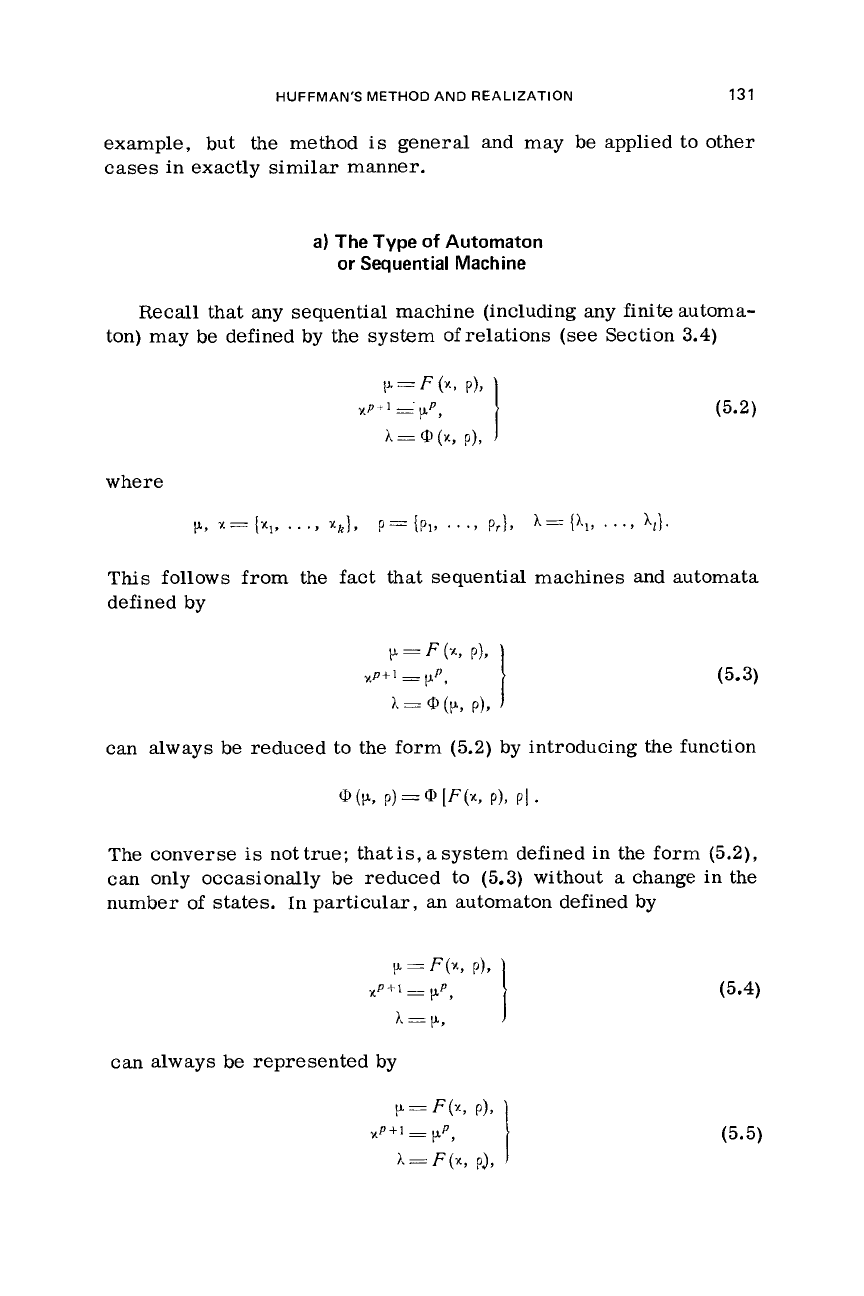
HUFFMAN’S METHOD AND REALIZATION
131
example,
but
the
method
is
general and may be applied to other
cases
in exactly similar manner.
a) The
Type
of Automaton
or
Sequential
Machine
Recall
that
any sequential machine (including any
finite
automa-
ton) may be defined by the system ofrelations
(see
Section
3.4)
where
This follows from the
fact
that sequential machines and automata
defined by
can always be reduced to the form
(5.2)
by introducing the function
The converse
is
nottrue; thatis, asystem defined in the form
(5.2),
can only occasionally be reduced
to
(5.3)
without
a
change in the
number of states. In particular, an automaton defined by
can always be represented by
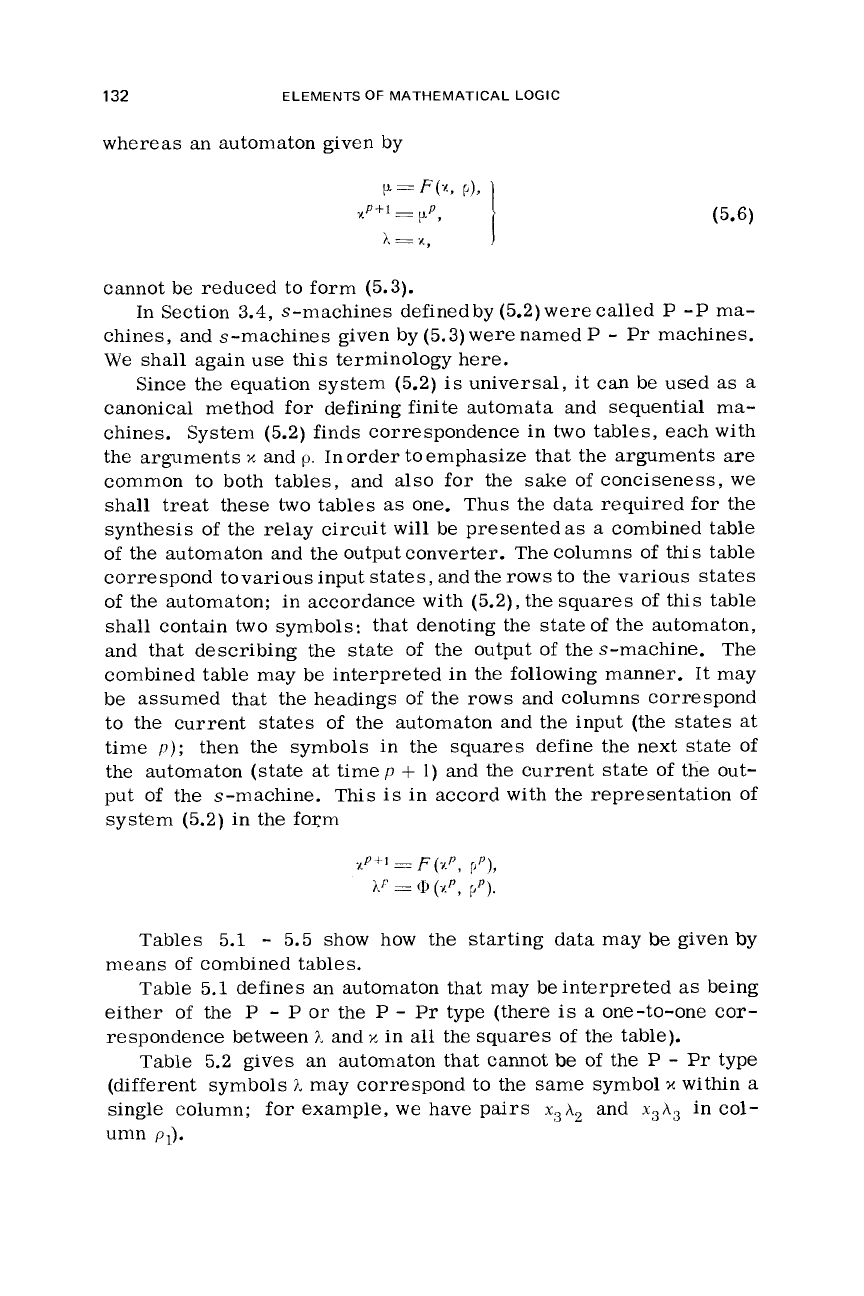
132
ELEMENTS
OF
MATHEMATICAL LOGIC
whereas an automaton given by
(5.6)
cannot be reduced to form (5.3).
In Section
3.4,
s-machines definedby (5.2) were called
P
-P
ma-
chines, and s-machines given by (5.3)
were
named
P
-
Pr
machines.
We
shall
again
use
this terminology here.
Since the equation system (5.2)
is
universal, it
can
be used
as
a
canonical method for defining finite automata and sequential ma-
chines. System (5.2) finds correspondence in
two
tables, each with
the arguments
Y,
and
p.
In order toemphasize that the arguments
are
common to both tables, and also for the
sake
of conciseness,
we
shall treat
these
two
tables
as
one. Thus the data required for the
synthesis of the relay circuit
will
be presentedas
a
combined table
of
the automaton and the output converter. The columns of
this
table
correspond tovariousinput states, and the rows to the various states
of the automaton; in accordance
with
(5.2), the squares
of
this table
shall contain
two
symbols: that denoting the stateof the automaton,
and that describing the state of the output of thes-machine. The
combined table may be interpreted in the following manner. It may
be assumed that
the
headings
of
the rows and columns correspond
to the current states of the automaton and the input (the states at
time
p);
then the symbols in the squares define the next state of
the
automaton (state at time
p
+
1)
and the current state of the out-
put of the s-machine. This
is
in accord with the representation of
system (5.2) in the form
Tables
5.1
-
5.5 show how
the
starting data may be given by
means of combined tables.
Table 5.1 defines an automaton that may beinterpreted
as
being
either of the
P
-
P
or
the
P
-
Pr
type (there
is
a
one-to-one cor-
respondence between
1.,
and
y.
in
all
the squares of the table).
Table 5.2 gives an automaton that cannot be of the
P
-
Pr
type
(different symbols
7,
may correspond to the same symbol
x
within
a
single column; for example, we have pairs
x3h2
and
x3h3
in col-
umn
P,).
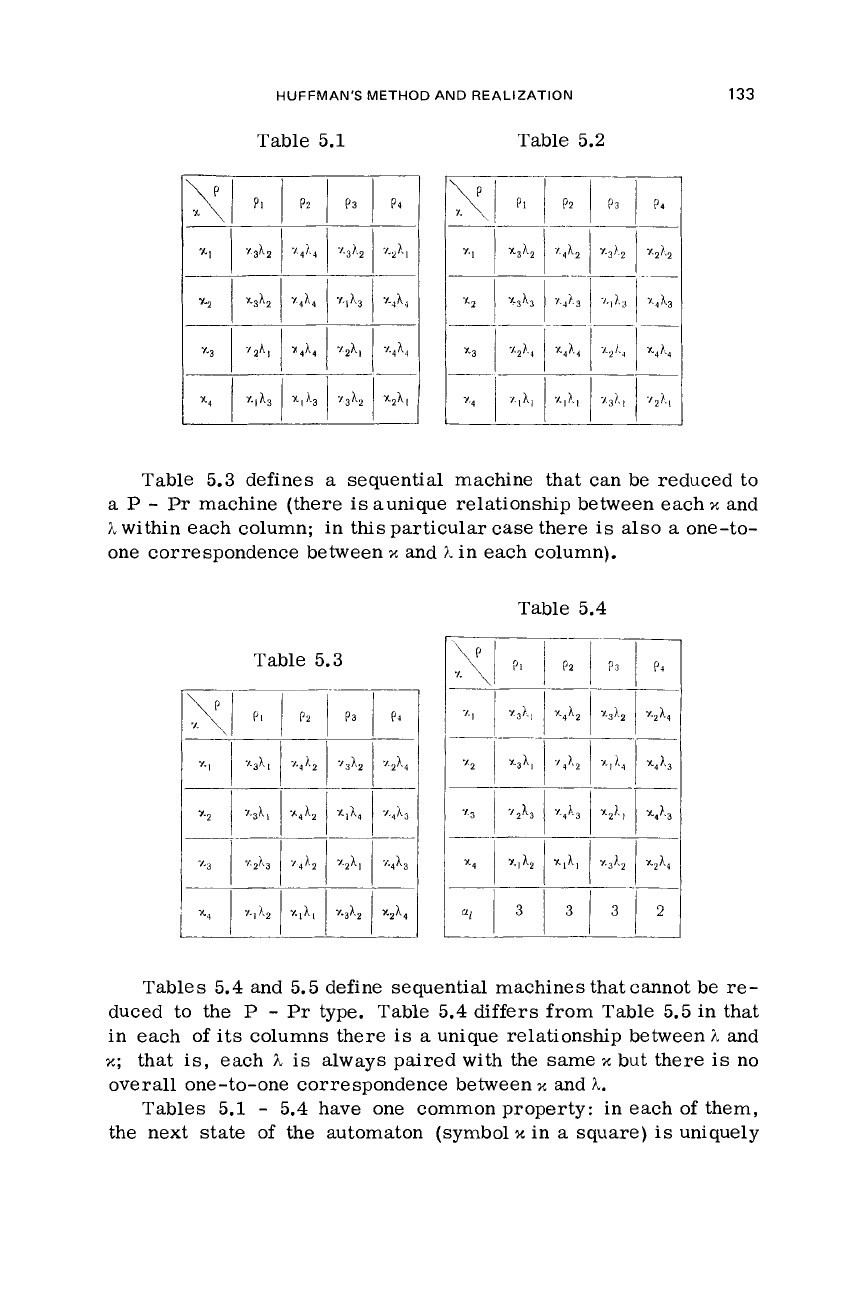
HUFFMAN'S METHOD AND REALIZATION
133
Table 5.1 Table 5.2
74
Table 5.3 defines
a
sequential machine that can be reduced to
a
P
-
Pr
machine
(there
is
aunique relationship between each
x.
and
h
within
each
column; in
this
particular case there
is
also
a
one-to-
one correspondence between
x
and
1.
in
each
column).
Table 5.3
T:
Pi
Tables 5.4 and 5.5 define sequential machines that cannot be
re-
duced to the
P
-
Pr
type. Table 5.4
differs
from Table 5.5 in that
in each
of
its columns there
is
a
unique relationship between
h
and
x;
that
is,
each
h
is
always paired with the same
3c
but there
is
no
overall one-to-one correspondence between
7c
and
h.
Tables 5.1
-
5.4
have one common property: in each of them,
the
next state
of
the
automaton (symbol
3c
in
a
square)
is
uniquely
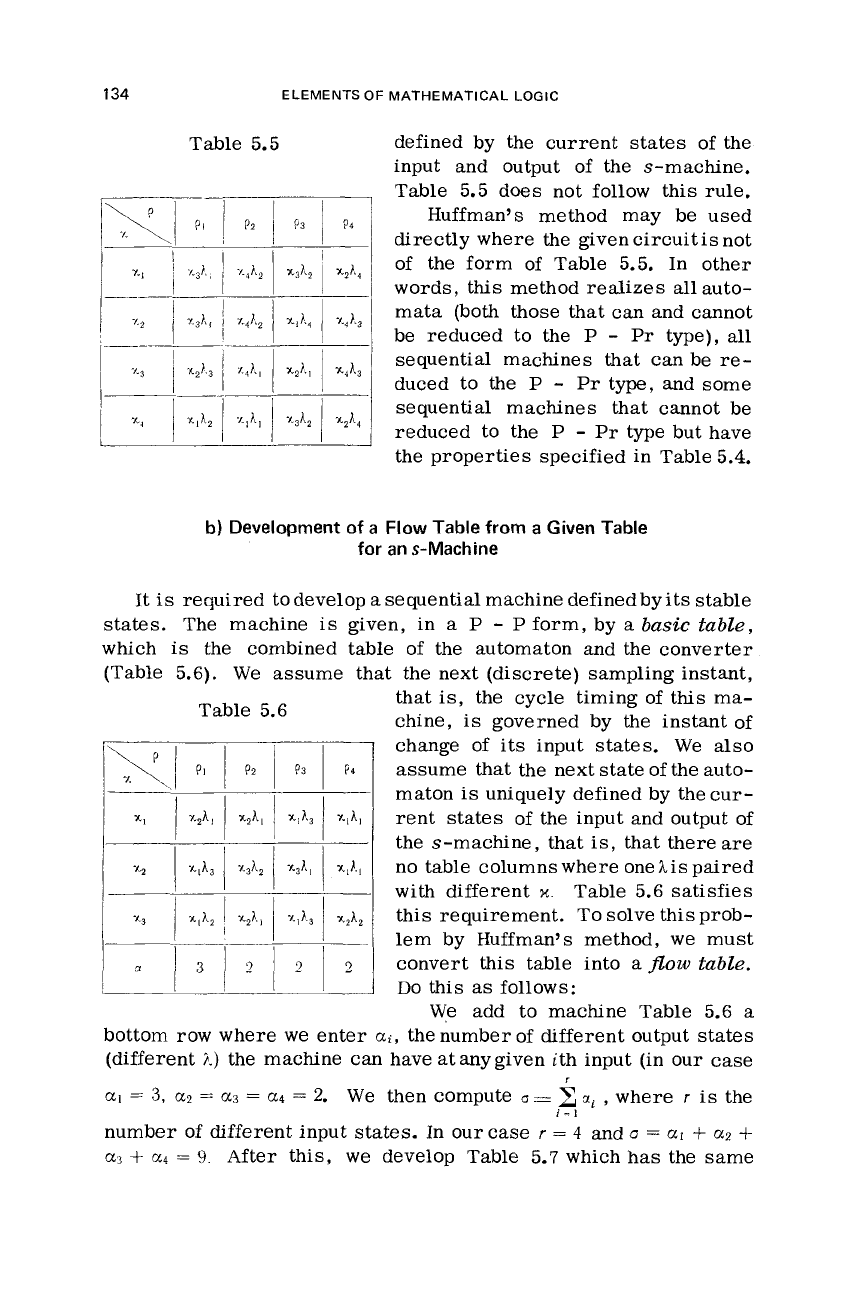
134
ELEMENTS
OF
MATHEMATICAL LOGIC
Table 5.5
defined by the current
states
of the
input and output of
the
s-machine.
Table 5.5 does not follow this rule.
Huffman's method may be used
directly
where
the given circuit
is
not
of the form of Table 5.5. In other
words,
this
method realizes
all
auto-
mata (both those that can and cannot
be reduced
to
the
P
-
Pr
type),
all
sequential machines that can be
re-
duced to the
P
-
Pr
type, and some
sequential machines that cannot be
reduced to the
P
-
Pr
type but have
the properties specified in Table 5.4.
b) Development
of
a
Flow
Table
from
a Given Table
for
an s-Machine
It
is
required to develop
a
sequential machine defined by
its
stable
states. The machine
is
given, in
a
P
-
P
form, by
a
basic table,
which
is
the combined table of the automaton
and
the converter
(Table
5.6).
We
assume that the next (discrete) sampling instant,
Table 5.6
that
is,
the
cycle timing of this ma-
chine,
is
governed by the instant of
change of
its
input states.
We
also
assume
that
the next state of the auto-
maton
is
uniquely defined by the cur-
rent states of the input and output of
the
s-machine, that
is,
that there
are
no
table columns where one
his
paired
with different
?t.
Table 5.6 satisfies
this requirement. To solve this prob-
lem by Huffman's method,
we
must
convert this table into
a
flow
table.
Do
this
as
follows:
We
add to machine Table 5.6
a
bottom row where
we
enter
ai,
the number of different output states
(different
iL)
the
machine can have
at
any
given ith input (in our
case
CLI
=
3,
a2
=
a3
=
CL~
=
2.
We
then compute
a
=
xi
,
where
r
is
the
number of different input states.
In
ourcase
r
=
4
and
o
=
a1
+
az
+
a3
+
a4
=
9.
After this,
we
develop Table 5.7 which
has
the same
r
i=l
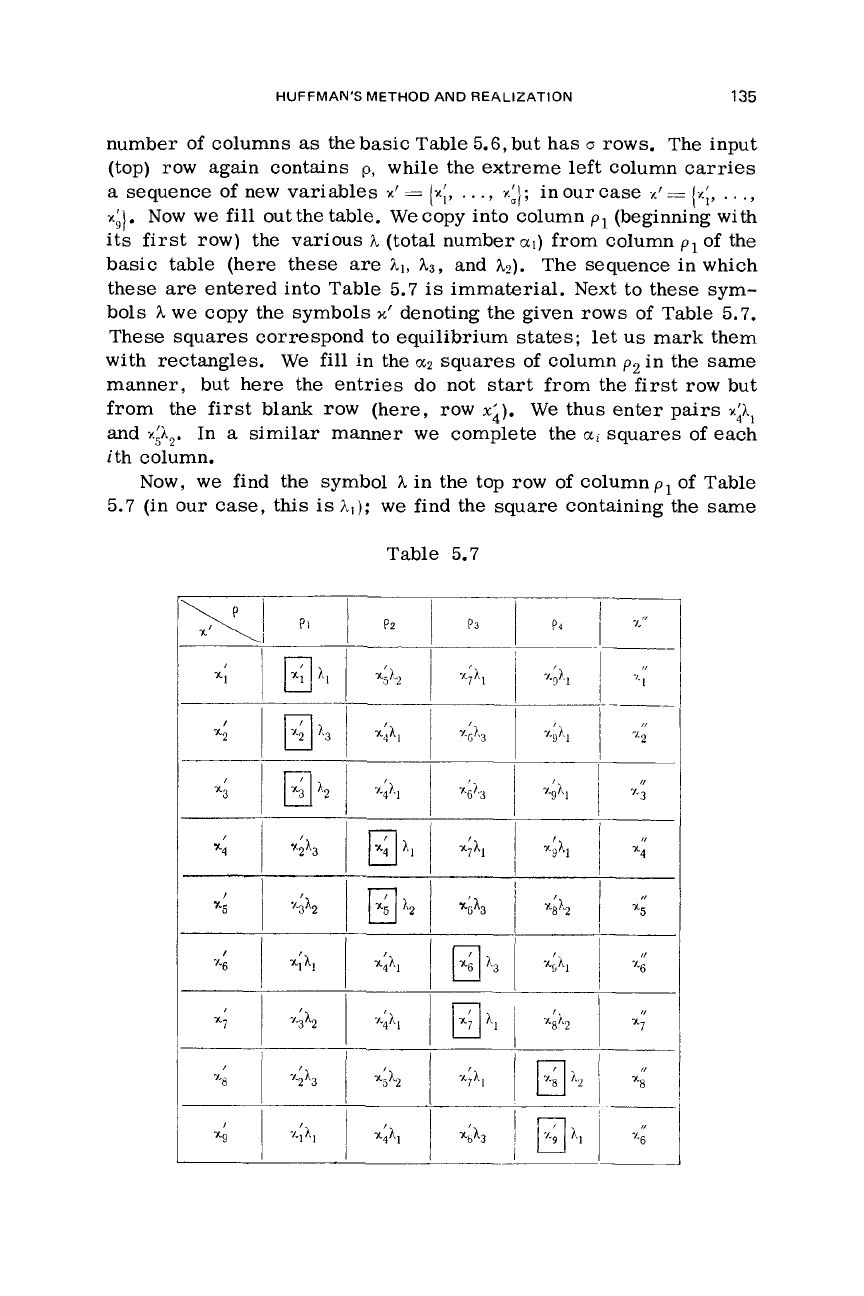
HUFFMAN'S METHOD AND REALIZATION
135
number of columns
as
the
basic Table 5.6, but has
u
rows. The input
(top) row again contains
p,
while the extreme left column
carries
a
sequence of new variables
X'
=
{xi,
.
. .
,
~11:
in our case
X'
==
{x;,
.
.
.
,
xi).
Now we
fill
out the table.
We
copy into column
p1
(beginning
with
its first row) the various
h
(total number
a,)
from column
p1
of the
basic table (here these
are
hi,
h3,
and
A?).
The sequence in which
these
are
entered into Table 5.7
is
immaterial. Next to these sym-
bols
h
we
copy the symbols
XI
denoting the given rows of Table 5.7.
These squares correspond to equilibrium states;
let
us mark them
with rectangles.
We
fill in the
a2
squares
of
column
pg
in the same
manner, but here the entries do not start from the first row but
from the
first
blank row (here, row
xi).
We
thus enter pairs
~;h,
and
x,&.
In
a
similar manner
we
complete the
a:
squares of each
ith column.
Now, we find the symbol
h
in the top row of column
p,
of Table
5.7 (in our case
I
X2
I
x3
I
x4
I
"6
,
"8
I
X9
this
is
hl);
we
find the square containingthe same
Table 5.7
I
I
PI
I
P2
1
P3
I
n
I
y'
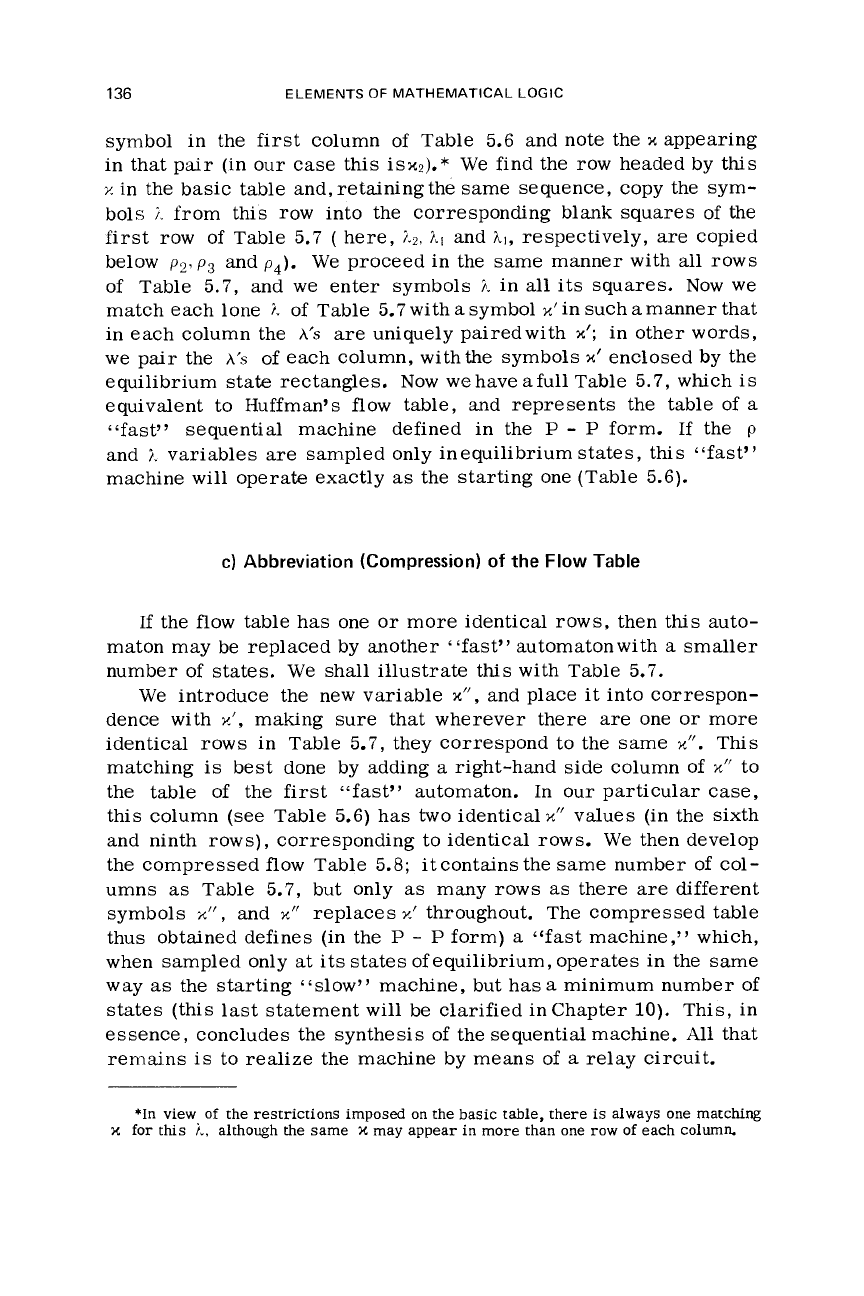
136
ELEMENTS
OF
MATHEMATICAL LOGIC
symbol
in the first column of Table 5.6 and note the
x
appearing
in that pair (in our case this isx2).*
We
find the row
headed
by
this
x
in the basic table and, retaining the same sequence, copy the sym-
bols
i.
from this row into the corresponding blank squares of the
first row
of
Table 5.7
(
here,
LL,
A,
and
A,,
respectively,
are
copied
below
p2,
pg
and
p4).
We
proceed in the same manner with
all
rows
of Table 5.7, and
we
enter symbols
h
in
all
its squares. Now
we
match
each
lone
i.
of Table 5.7 with
a
symbol
XI
in
such
a
manner that
in each column the
A‘s
are
uniquely pairedwith
x’;
in other words,
we
pair the
A’S
of
each
column, withthe symbols
x’
enclosed by the
equilibrium
state
rectangles. Now
we
have afull Table 5.7,
which
is
equivalent to Huffman’s flow table, and represents the table of
a
“fast” sequential machine defined in the
P
-
P
form. If the
p
and
7.
variables
are
sampled only inequilibrium states, this “fast”
machine
will
operate exactly as the starting one (Table 5.6).
c)
Abbreviation (Compression)
of
the
Flow
Table
If the flow table
has
one or more identical rows, then this auto-
maton may be replaced by another “fast” automatonwith
a
smaller
number of states.
We
shall illustrate this with Table 5.7.
We
introduce the new variable
XI’,
and place it into correspon-
dence with
d,
making sure that wherever there
are
one
or
more
identical rows in Table 5.7, they correspond to the same
x“.
This
matching
is
best done by adding
a
right-hand
side
column of
XI‘
to
the table of the first “fast” automaton. In our particular case,
this column
(see
Table 5.6)
has
two
identical
X”
values (in the sixth
and ninth rows), corresponding to identical rows.
We
then develop
the compressed flow Table 5.8;
it
contains the same number of col-
umns
as
Table 5.7, but only
as
many rows
as
there
are
different
symbols
x”,
and
?t”
replaces
x‘
throughout. The compressed table
thus obtained defines (in the
P
-
P
form)
a
“fast
machine,” which,
when sampled only at its states
of
equilibrium, operates in the
same
way as the starting cLslow9’ machine, but
has
a
minimum number of
states (this last statement will be clarified in Chapter
10).
This, in
essence, concludes the synthesis of the sequential machine.
All
that
remains
is
to realize the machine by means of
a
relay circuit.
*In view
of
the restrictions imposed on the basic table, there
is
always one matching
x
for this
i,,
although the same
x
may appear in more than one row
of
each column.
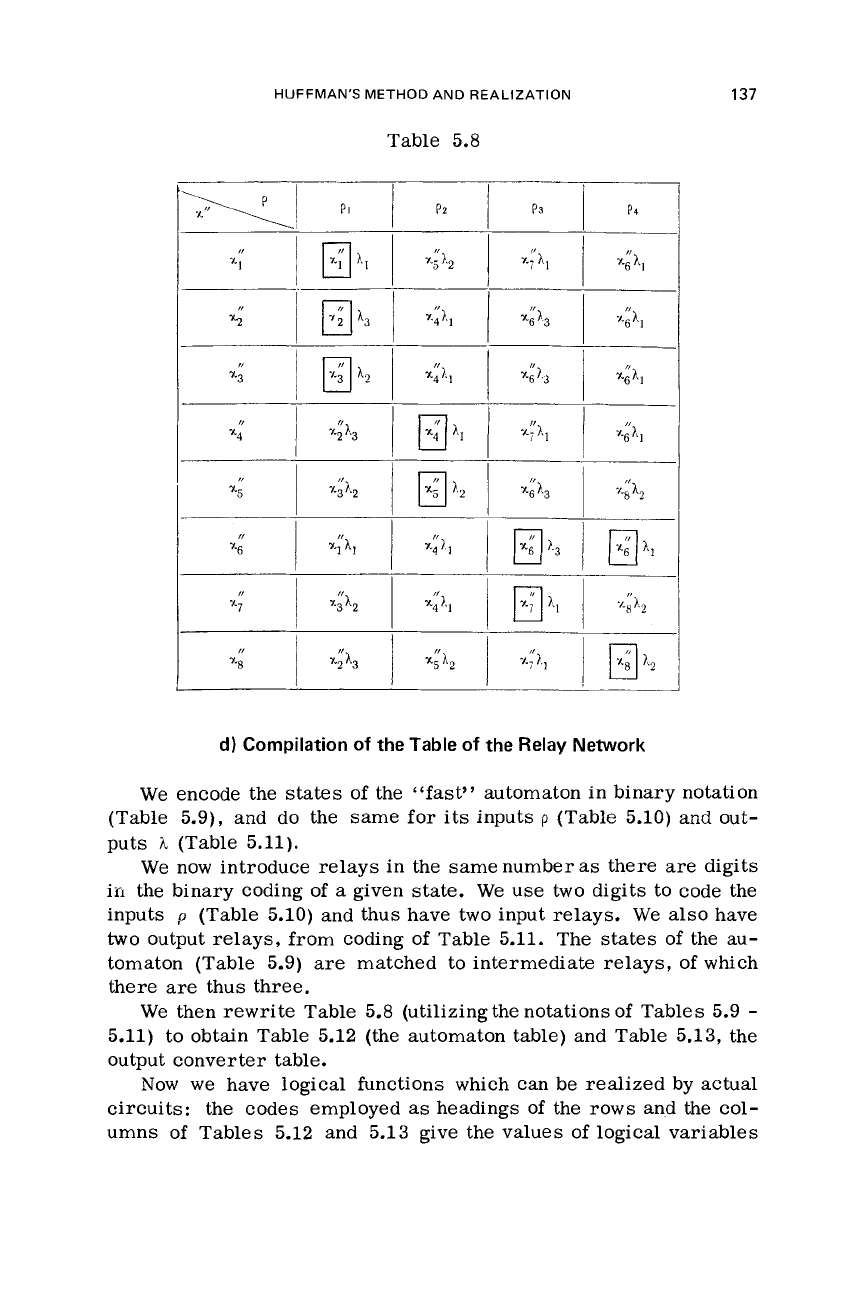
HUFFMAN'S
METHOD
AND REALIZATION
137
Table 5.8
d)
Compilation
of
the Table
of
the Relay Network
We
encode the states
of
the
"fast"
automaton in binary notation
(Table 5.9), and do the same for its inputs
p
(Table 5.10) and out-
puts
h
(Table 5.11).
We
now introduce relays in the same number
as
there
are
digits
in
the
binary coding of
a
given state.
We
use two digits to code the
inputs
p
(Table 5.10) and thus have two input
relays.
We
also have
two
output relays, from coding of Table 5.11. The states
of
the au-
tomaton (Table
5.9)
are
matched to intermediate relays,
of
which
there
are
thus three.
We
then rewrite Table 5.8 (utilizing the notations of Tables 5.9
-
5.11)
to obtain Table 5.12 (the automaton table) and Table 5.13, the
output converter table.
Now
we
have logical functions which can be realized by actual
circuits: the codes employed
as
headings of the
rows
and the col-
umns
of
Tables 5.12 and 5.13 give the values of logical variables
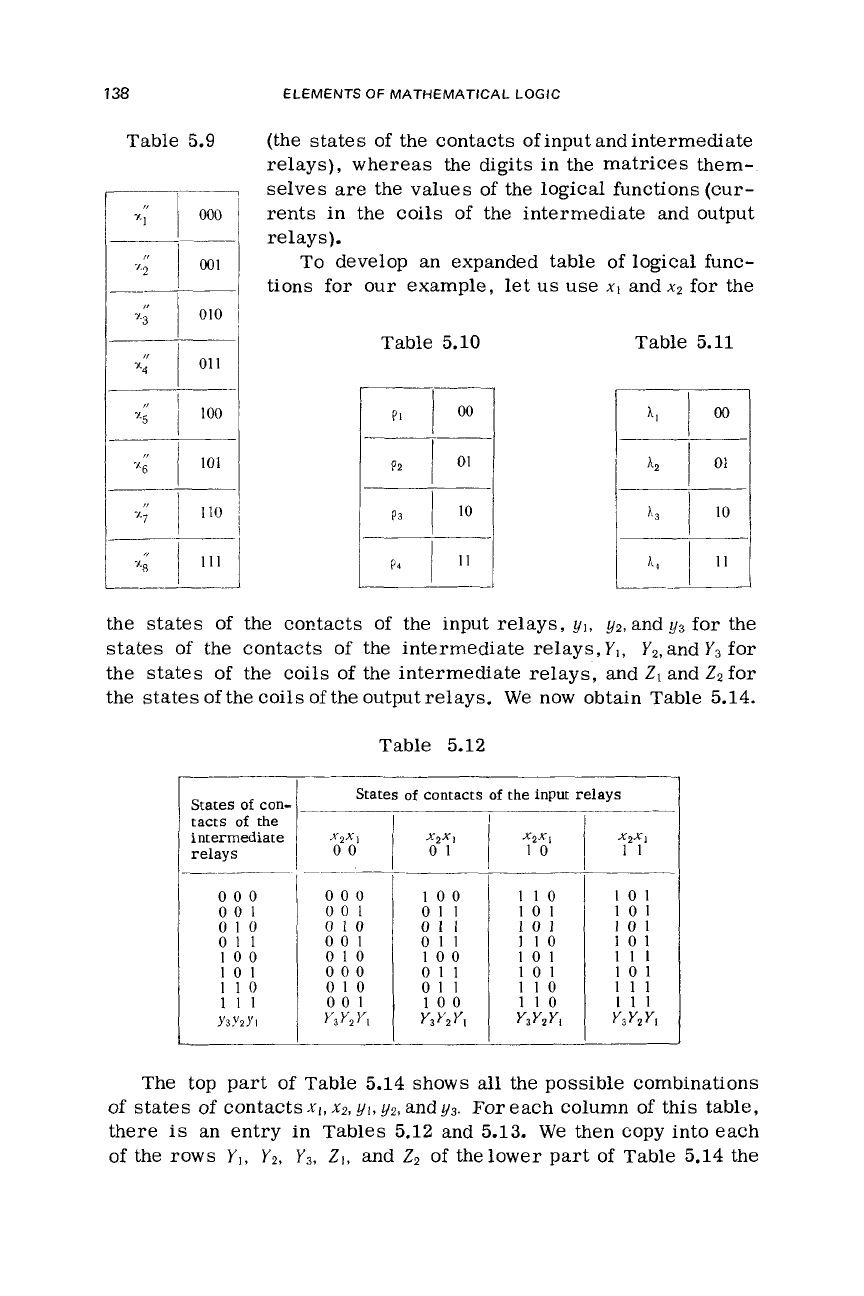
138
ELEMENTS
OF
MATHEMATICAL LOGIC
000
00
1
010
011
000
100
110
101
00
1
01
1
101
101
010
01
I
101
101
001
011
110
101
the
states
of
the coctacts of the input relays,
yl,
yz,
and
y3
for the
states
of
the contacts
of
the intermediate relays,
Yi,
Yz,
and
Y3
for
the states
of
the coils
of
the intermediate relays, and
Z1
and Zzfor
the states
of
the coils
of
the output relays.
We
now obtain Table
5.14.
Table
5.12
States
of
contacts
of
the
input
relays
______-
__
The top part
of
Table
5.14
shows
all
the possible combinations
of
states
of
contacts.rl,
XZ,
yi,
yz,
andy3.
For
each column
of
this table,
there
is
an entry in Tables
5.12
and
5.13.
We
then copy into
each
of
the rows
Y1,
Yz,
Y3.
Z,,
and
Z2
of
thelower part
of
Table
5.14
the
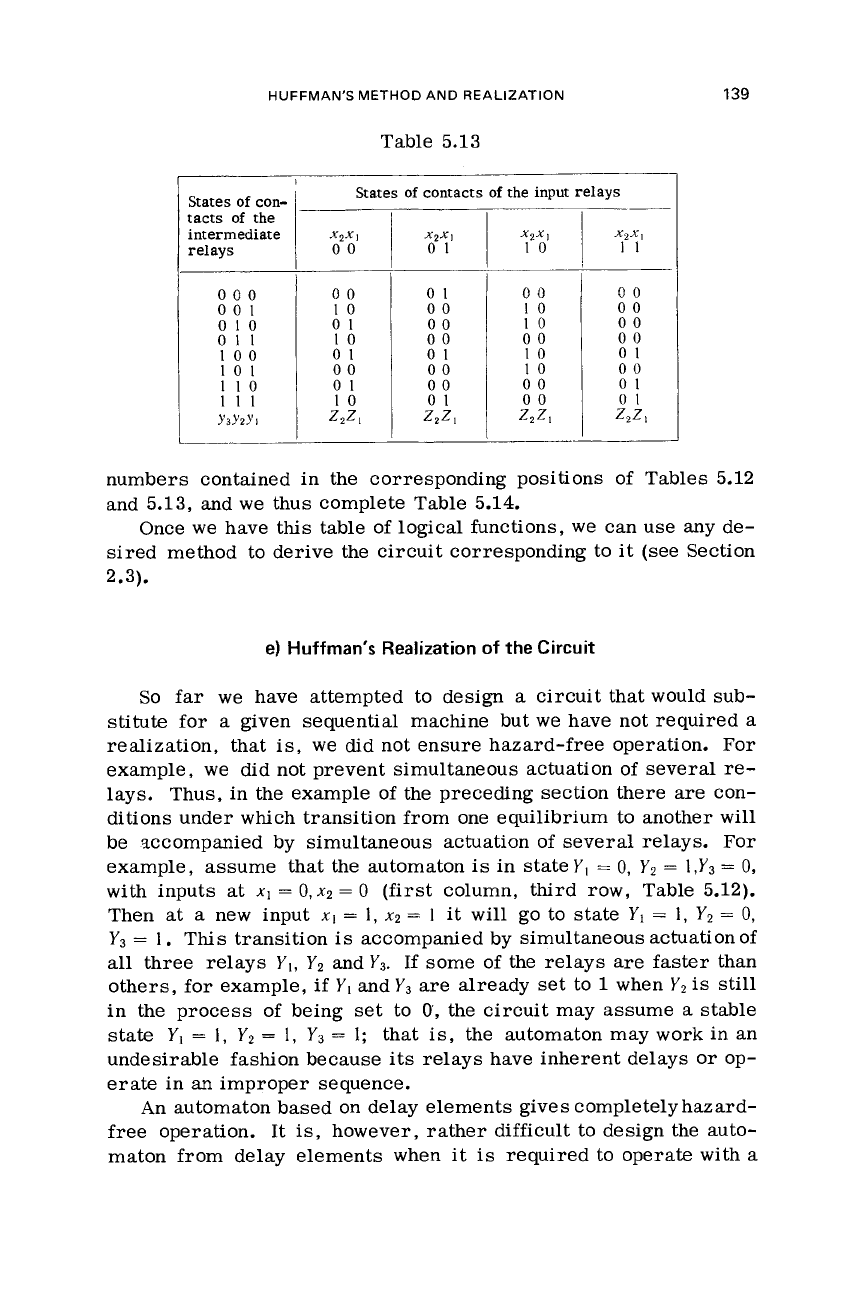
HUFFMAN'S METHOD AND REALIZATION
tacts of the
I
139
I
Table 5.13
00
10
10
00
10
10
00
00
ZJ,
00
00
00
00
01
00
01
01
Z2-I
intermediate
relays
01
000
001
010
011
100
101
110
111
Y3YZ)'l
00
10
01
10
01
00
01
10
ZJI
01
00
00
00
01
00
00
01
1
z2z
x2x
I
10
1
numbers contained in the corresponding positions
of
Tables 5.12
and 5.13, and
we
thus complete Table 5.14.
Once
we
have this table of logical functions,
we
can use any
de-
sired
method to derive
the
circuit corresponding to it
(see
Section
2.3).
e) Huffman's Realization
of
the
Circuit
So
far
we
have attempted to design
a
circuit that would sub-
stitute for
a
given sequential machine but
we
have not required
a
realization, that
is,
we
did
not ensure hazard-free operation.
For
example,
we
did not prevent simultaneous actuation of several
re-
lays. Thus, in the example of the preceding section there
are
con-
ditions under
which
transition from one equilibrium to another
will
be sccompanied by simultaneous actuation of several relays.
For
example, assume that the automaton
is
in state
Y,
=
0,
Y2
=
1,Y3
=
0,
with inputs at
x1
=
O,xp
=
0
(first column, third row,
Table 5.12).
Then
at
a
new input
xI
=
I,
xp
=
1
it will go to state
Y,
=
1,
Y2
=
0,
Y3
=
1.
This transition
is
accompanied by simultaneous actuation of
all
three relays
Y1,
Yz
andYB.
If
some
of
the
relays
are
faster
than
others, for example,
if
Y,
and
YB
are
already set to
1
when
Yz
is
still
in the process of being set to
0,
the circuit may assume
a
stable
state
Y1
=
I,
Y2
=
1,
Y3
=
1;
that
is,
the
automaton may work in an
undesirable fashion because its relays have inherent delays
or
op-
erate
in an improper sequence.
An automaton based on delay elements gives completely hazard-
free
operation. It is, however, rather difficult to design
the
auto-
maton from delay elements when it
is
required to operate with
a
